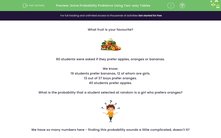What fruit is your favourite?

80 students were asked if they prefer apples, oranges or bananas.
We know:
19 students prefer bananas, 12 of whom are girls.
13 out of 37 boys prefer oranges.
40 students prefer apples.
What is the probability that a student selected at random is a girl who prefers oranges?

We have so many numbers here - finding this probability sounds a little complicated, doesn't it?
But it doesn't have to be if we organise this data into a two-way table:

We found the numbers we were not given by using the totals.
For example, we were told that 19 students prefer bananas, 12 of whom are girls.
So the number of boys who prefer bananas is 19 - 12 = 7
We want to find the probability that a student selected at random is a girl who prefers oranges.
From the table we can see that there are 8 girls who prefer oranges.
Since there are 80 students in total, the probability that a student selected at random is a girl who prefers oranges is 8/80 = 1/10
Didn't having the two-way table make it so much easier?!

We could also use it to find something called conditional probability.
Conditional probability is the probability that something happens given that something else happens or has happened.
I.e. there is a condition.
For example, let's say we want to find the probability that a student selected at random likes apples given that the student is a boy.
Here, our condition is that the student is a boy.
So the denominator of the probability will be the number of boys, i.e. how many students satisfy our condition.

We can see there are 40 boys altogether.
So the denominator of our probability will be 40.
In the numerator, we have the number of desired outcomes (as with any other probability!).
In this case, it is the number of boys who like apples (the students who are both boys (our condition) and like apples (what we want the probability of).
17 boys like apples, so the numerator will be 17.
Putting it all together, 17 out of 40 boys like apples, so the probability that a student selected at random likes apples given that the student is a boy is 17/40
Phew!
.jpg)
Let's put this all into practice!








